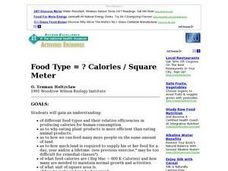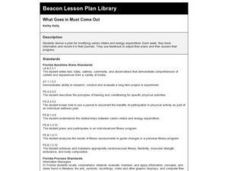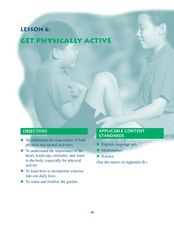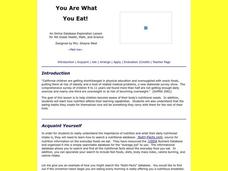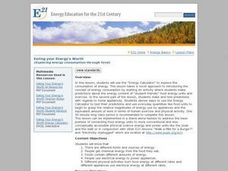Curated OER
Math in Science-Knowing the Calories You Take In!
I can burn off one scrambled egg in 30 minutes of walking? Explain how we daily consume and burn calories using this fun worksheet, which breaks down basic foods and activities into kilocalorie equivalents. Nutritionists calculate the...
Texas State Energy Conservation Office
Nuts! Calculating Thermal Efficiency
Oh nuts! Do macadamias or almonds produce more thermal energy? Energy enthusiasts find out with this experiment. The objective is to demonstrate to your class how the chemical energy contained in foods can be converted into useable...
Kenan Fellows
How Much Energy Is That Anyway?
The fifth lesson in the six part series introduces units of energy including calories, Calories, and joules. Scholars determine the energy released when eating a snack and during activity.
Curated OER
How Much Do You Burn?
Sixth graders discover their weight relative to the other children in their class. They determine how many calories they burn through exercise and compare it with their classmates. Using the internet, they calculate their body mass index...
Curated OER
Diet, Exercise and AIDS
Students research AIDS and the role of diet and exercise with the disease. In this AIDS lesson, students listen to a mini lecture about the diet and exercise needs of people who have AIDS. Students learn about alternative therapies to...
Curated OER
Calories
Students explore calories. In this lesson about calories, students practice counting and recording calories. Students use a sample Calorie Calculation Chart to record how many calories consumed in one day. Students do an experiment on...
Curated OER
Food Type And Calories Per Square Meter
Students compare the efficiency of producing food calories in different types of food then calculate how much land is required to supply their food for a year. They then graph the results.
Curated OER
What Goes in Must Come Out
Students monitor their calorie intake and energy expenditure. They keep track of daily data in a journal and assess and adjust their diets as appropriate.
Curated OER
Label Language
Sixth graders explore healthy eating habits by identifying food labels. In this food ingredient lesson, 6th graders discuss the nutritional facts that are available on almost all foods in America and which ingredients and content is...
Curated OER
You Are What You Eat!
Students calculate the calorie content of food. In this chemistry lesson plan, students plan a healthy meal based on RDA. They devise an exercise to burn extra calories.
Curated OER
Get Physically Active
Learners discover the importance of water. In this physical education science lesson, students consider mental and physical activities. Learners find their pulse and measure their heart rate. Students discuss the importance...
Curated OER
Cellular Respiration
In this cellular respiration learning exercise, students answer 34 questions in a variety of types including fill in the blank, short answer and matching. All questions focus on specific parts of the respiration process.
Curated OER
Cellular Respiration
In this cellular respiration worksheet, students compare the following processes: cellular respiration, glycolysis, lactic acid fermentation, and alcoholic fermentation. This worksheet has 9 short answer, 6 matching, 3 multiple choice,...
Curated OER
Walk a Mile for a Burger?
Students are introduced to the pedometer, and use this tool to associate physical activity (physical energy) with calories burned (chemical energy). They comprehend the making and burning of energy.
Curated OER
Measuring the Heat Energy of a Chemical Change
Students investigate the Law of Conservation of Energy and the relationship between heat and temperature. In this heat energy and chemical changes lesson, students observe a candle heating a paper cup of water and make predictions about...
Texas Heart Institute
Nutrition: How Do I Choose the Right Foods?
Young learners discuss how to practice healthy eating habits and the body's need for energy through discussion and exploration of the MyPlate system.
Curated OER
What Should I Know about Respiration
How are kids supposed to know what to study for that cellular respiration test? With a study guide or reading guide like the one found here. With three pages of questions important to the understanding of respiration and the processes...
Curated OER
You Are What You Eat!
Fourth graders discover the nutritional needs of their bodies. Using a database, they research how nutrition affects their learning capabilities. They take the food they eat on a daily basis and discover its nutritional value. They...
Curated OER
Castaway or Survivor
What a clever idea! Chemistry learners imagine themselves deserted on an island with a radio, but no batteries. They also have a few odds and ends in their pockets and storage chest. They are challenged to create a battery that will...
Curated OER
Stamp Boxes or Jars: Recycled Art
With some canceled stamps, an old box, and some glue, learners create art from scraps. You save up or gather used postage stamps, the kids glue them onto a box or an old clean jar. All the steps needed to complete this project plus two...
Curated OER
Will Smog be a Problem at the Olympic Games?
Learners locate China on a world map, then read a news article about pollution in Beijing. In this current events lesson, the teacher introduces the article with a discussion about smog and a vocabulary activity, then students read the...
Curated OER
Cancer
Students study cancer and possible preventative measures. In this cancer lesson students study the claims on food labels and ways to lower your risk of cancer.
Curated OER
Food Pyramid Menu
Students analyze the food pyramid. In this food pyramid instructional activity, students evaluate their nutritional needs. Students record their eating habits and determine if their food choices were healthy.
Curated OER
Eating your Energy's Worth
Students calculate the amount of electrical energy used in a week in food units. They create ways to reduce energy use. Students discuss the different forms and sources of energy. They discuss how people use electrical energy to power...






